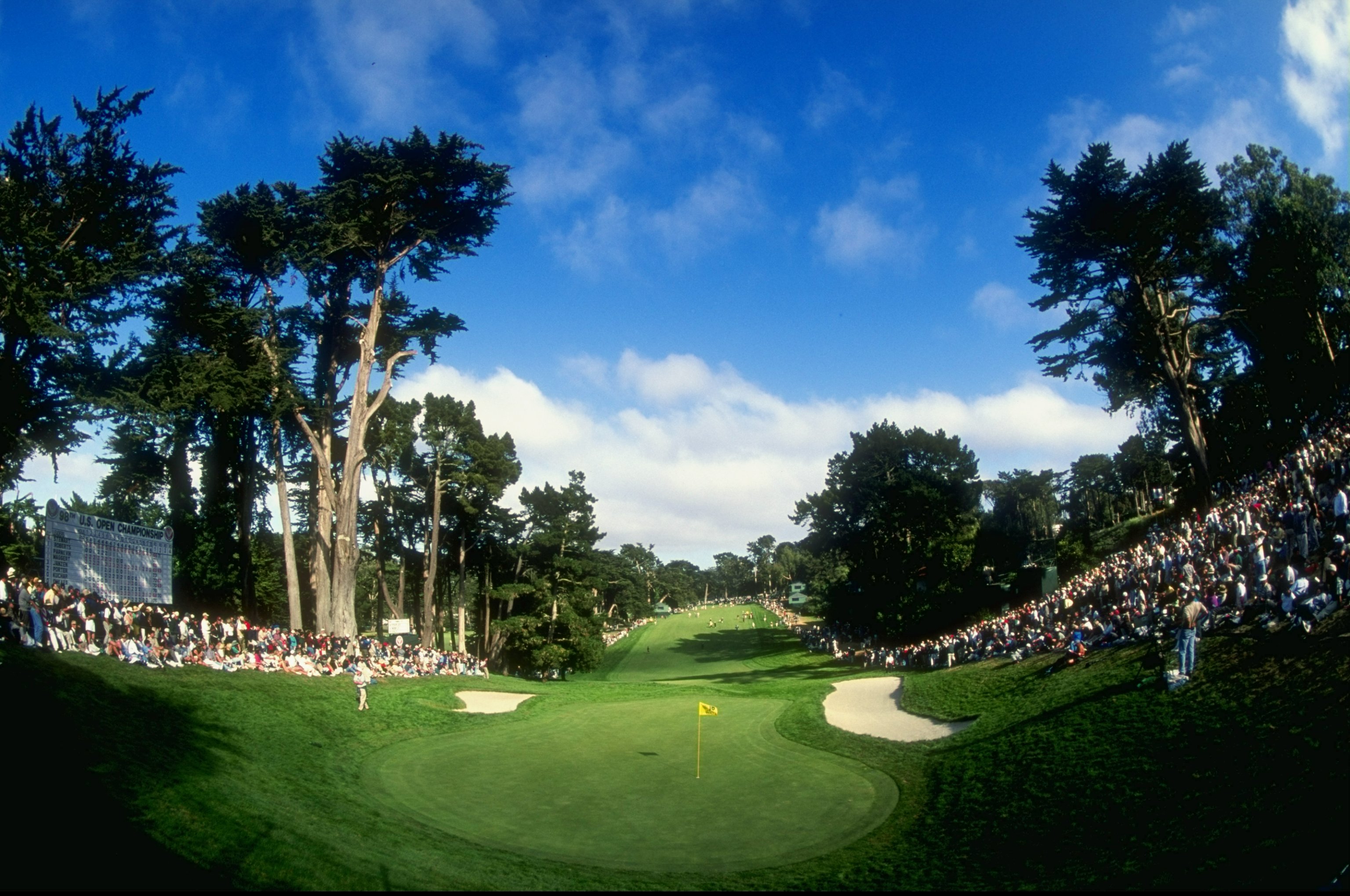'They've Lost The Golf Course', Mickelson's Moving Ball And 'We Played Twilight Golf' - 9 US Open Controversies
A look at some of the US Open controversies through the years - there have been quite a lot of them

Elliott Heath

The USGA has been renowned for setting up US Open courses to be brutally punishing, often controversially so.
In this piece we take a look at some of the most controversial moments from previous US Open tournaments, from extreme course setups to hole locations and rules controversies.
We start with Ernie Els in 1994...
1: Ernie Els' drop, Oakmont 1994

After a superb third round of 66, Ernie Els took a three-shot lead into the final day at Oakmont in 1994. But the 24-year-old started poorly on Sunday with a hook into horrific rough. It looked as though the South African would do well simply to extricate his ball from the tangled lie, let alone reach the green.
But, when Els reached the spot, it was apparent that a camera crane was in his line. A rules official stated the crane was an immovable obstruction and, as such, Els was granted a free drop, which he took in a clear, and massively more playable, spot.
That might have seemed like just a lucky break, but the thing was that the crane was actually perfectly moveable. It had been moved four times already on Sunday before Els arrived and, as soon as he played, it was moved again to cover the action on another part of the course. The rules official would later admit that he got it wrong.
Els finished the day tied at the top of the leaderboard with Colin Montgomerie and Loren Roberts and then went on to win an 18-hole playoff the following day.
Subscribe to the Golf Monthly newsletter to stay up to date with all the latest tour news, equipment news, reviews, head-to-heads and buyer’s guides from our team of experienced experts.
2: Pin position, Olympic Club 1998

The USGA often set hugely challenging pin positions in the US Open but, at Olympic Club in 1998, many felt they went too far with their choice of hole location on the 18th in the second round.
Set on a high point of green, numerous players who missed on their first try looked on in dismay as the ball ran back towards, and sometimes past, where they stood. The words Mickey and Mouse were bandied about that day.
3: The Hinkle Tree, Inverness Club 1979
Coming to the 8th hole in the first round at Inverness, Lon Hinkle saw an unconventional option off the tee. Aiming at a small gap in the trees he fired through and down the 17th fairway, dramatically reducing the length of the par 5.
He made a birdie four. Hinkle’s playing partner Chi Chi Rodriguez and a number of others copied the strategy.
The following day, the shortcut was no longer an option. Overnight, the chairman of the greens committee had paid to have a fairly sizeable tree installed in the gap. It, predictably, became known as "The Hinkle Tree".
4: 260 yard carry into wind, Bethpage Black 2002

Davis Love III in the rough on 10 at Bethpage
A 260-yard carry to the fairway sounds pretty brutal. Try adding a strong headwind and soft ground conditions. That’s what happened on the par-4 10th hole at Bethpage in 2002.
It became a nightmare for the shorter hitters and the scoring average over the weekend went up to 4.5. The feeling was that the set-up of the hole favored the bombers to too great an extent.
“I reckon 50 per cent of the field couldn’t reach that fairway,” said Mike Weir afterwards.
5: Watering the greens at Shinnecock Hills, 2004

The players started a bit too well at Shinnecock in 2004. After two rounds, 11 of them were under par, and the USGA didn’t like it. They decided the most sensible course of action was to stop watering the course to firm it up.
Unfortunately, by the final round, they’d pretty much lost the greens and were having to water them between groups just to keep them vaguely playable. Vaguely would be the operative word – the scoring average on the final day was an astonishing 78.7.
By the end, only two men broke par: winner Retief Goosen and US Open nearly man Phil Mickelson.
6: Broccoli greens, Chambers Bay 2015

The greens were the big talking point at the 2015 US Open
This ended up being Jordan Spieth's second Major win of the year, after recording a winning score of five-under-par to finish one ahead of fellow American Dustin Johnson.
However, the news of the week circled around the controversial putting surfaces.
Colin Montgomerie, who finished on +13 in a tie for 64th, described the greens in his pre-tournament warm up rounds as: "Very, very poor. The quality of the surface of the greens is extremely poor. That is going to take away the consistency of the putts. The 10-footers that you see people hole all the time, that won’t be happening this week. The greens are extremely poor."
Fellow professionals, most notably Ian Poulter and Sergio Garcia, supported Montgomerie's critique of the Chambers Bay greens. Henrik Stenson said it was "pretty much like putting on broccoli."
Dustin Johnson infamously three-putted the final green to hand Spieth the title.
With only eight players finishing under par that week, it was clear that the greens finitely were not up to Major championship standard. Although Spieth won't care about that.
7: DJ's penalty, Oakmont 2016

Dustin Johnson won in 2016 despite a controversial penalty - which wasn't decided until after he finished
Following the controversy at Chambers Bay the year before, there was yet more US Open drama at the 2016 championship, in which Dustin Johnson won his first Major title.
When Johnson's ball moved on the 5th green during his final round, without him approaching it, he stopped and made sure he interpreted the ruling correctly.
More than an hour later, the USGA informed Johnson it was unsure if he should be penalized a stroke under the idea that he had forced the ball to move.
The USGA notified Johnson that the action on the 5th green would be reviewed and ruled upon at the end of his round. The American was eventually given a penalty stroke, dropping him back to four-under-par, but it still meant he won the championship by three shots.
8: 'They've lost the golf course' and Mickelson's moving putt - Shinnecock Hills 2018
Phil Mickelson was having several issues during the third round of the 2018 US Open at Shinnecock Hills. After bogeying four of his last five, he headed to the 13th hole. Facing an 18-foot bogey putt down a fast slope, Lefty hit his putt too hard, but before his ball could go down another slope he ran after it and hit it again while it was still in motion.
Obviously against the rules, Mickelson managed to avoid disqualification despite their being justifiable reason to do so. He scored a 10 on the hole and drew an ire of criticism across the world of golf.
Indeed the 2018 tournament at Shinnecock was criticised mainly on Saturday because many believed the powers that be had lost the golf course.
Zach Johnson said the USGA had "lost the golf course" in a now-famous interview with Sky Sports Golf and said the tournament had come down to luck. Other players like Pat Perez criticised the unfairness of some of the pin positions too, such as those on the 13th and 15th.
Zach Johnson seems to have made his mind up on the ‘have they lost the course’ question @NoLayingUp @TronCarterNLU pic.twitter.com/E9VkWvPMALJune 16, 2018
9. 'Twilight golf' - LACC, 2023

The final group of Wyndham Clark and Rickie Fowler went off at 3.40pm local time in Saturday's third round of the 2023 US Open - and it was starting to get dark during the latter stages.
Eventual winner Clark said he "couldn't see" for the last two holes and that they were playing "twilight golf" for the closing stages. He put his bogey on the 17th as well as playing partner Rickie Fowler's bogey on 18 down to the darkness as the clouds began to sweep over LACC around 8pm local time.
"I mean, it's a little ridiculous that we teed off that late," Clark said.
"I would say right around hole 15 or 16 it started getting to where you couldn't see that well. I mean, I don't personally understand why we teed off - we played twilight golf.
"At the end, it was - the last two holes I 100 percent think my bogey on 17 was because I couldn't see, and I think Rickie's bogey on 18 was because he couldn't see.
"I'd like to see us go off an hour and a half, two hours earlier. If we had a playoff tomorrow we wouldn't even be able to play the playoff tomorrow because it was so dark."

Fergus is Golf Monthly's resident expert on the history of the game and has written extensively on that subject. He has also worked with Golf Monthly to produce a podcast series. Called 18 Majors: The Golf History Show it offers new and in-depth perspectives on some of the most important moments in golf's long history. You can find all the details about it here.
He is a golf obsessive and 1-handicapper. Growing up in the North East of Scotland, golf runs through his veins and his passion for the sport was bolstered during his time at St Andrews university studying history. He went on to earn a post graduate diploma from the London School of Journalism. Fergus has worked for Golf Monthly since 2004 and has written two books on the game; "Great Golf Debates" together with Jezz Ellwood of Golf Monthly and the history section of "The Ultimate Golf Book" together with Neil Tappin , also of Golf Monthly.
Fergus once shanked a ball from just over Granny Clark's Wynd on the 18th of the Old Course that struck the St Andrews Golf Club and rebounded into the Valley of Sin, from where he saved par. Who says there's no golfing god?
- Elliott HeathNews Editor